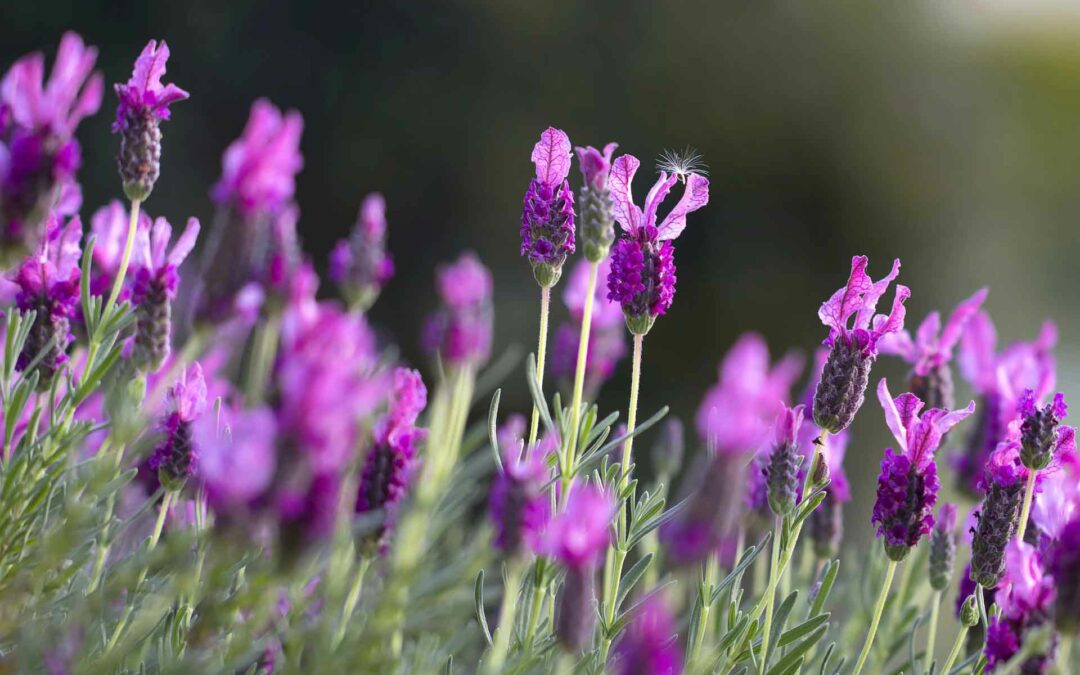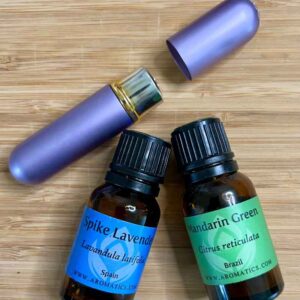Lavender vs. Spike Lavender Essential Oil: A Comprehensive Guide
Everyone is familiar with lavender essential oil. It’s the go-to for those seeking relaxation, thanks to its light, floral, sleep-inducing scent. But have you ever heard of spike lavender essential oil? Spike lavender is the lesser-known of the two lavender varieties. Keep reading to learn more about the chemical differences between these two essential oils, as well as how and when to use them in your aromatherapy practice. Lavender vs. spike lavender essential oil—the two are more complementary than competitive.
Lavandula angustifolia (Lavender)
Lavender essential oil is a must-have for any collection! It’s one of the most versatile and well-tolerated essential oils in aromatherapy. With a soft, floral, fresh aroma, lavender is gentle yet practical enough for nurturing sensitive areas through a difficult recovery process. Many studies show lavender’s main components, linalool and linalyl acetate, have a restorative influence on the entire system—body, heart, and mind. Lavender also has a special effect on the skin.
How to Use Lavender
Promote a Relaxing, Stress-Free Atmosphere
-
- Mix a few drops of lavender essential oil with a carrier oil like jojoba and apply to the back of the neck, arms, legs, or feet to relieve stress, soreness, and tension.
- Add a few drops to an essential oil diffuser to create a calm atmosphere for the whole family.
Skincare
-
- For acute skincare, blend a drop or two of lavender essential oil with aloe vera gel. If you have an aloe vera plant at home, use that. Apply the mixture directly to irritated areas as needed. For larger batches, refrigerate the mixture to prevent spoilage.
Shelf Life and Storage
The therapeutic-grade lavender essential oil has a shelf life of six years. Always store essential oils in dark glass bottles in a cool area, out of direct sunlight.
Safety
There are no known safety issues for Lavandula angustifolia (lavender) essential oil.
Lavandula latifolia (Spike Lavender) Essential Oil
Spike lavender essential oil, though from the same genus as Lavandula angustifolia, is a different species. It has a familiar floral aroma but with a more energizing, camphor-like refreshing scent. Spike lavender’s invigorating scent can help improve focus, making it great for workouts. In skincare blends, it can ease acute muscle discomfort or itchiness, purify the skin, and calm irritations.
How to Use Spike Lavender
Ease Sore, Tired Muscles
-
- After a workout, massage your muscles with a few drops of spike lavender blended with a carrier oil like jojoba to prevent tightness or cramping.
Fingernail and Toenail Discoloration
-
- Care for discolored or thickened nails with a soothing blend of spike lavender and coconut oil. Use daily.
Seasonal and Occasional Sinus Discomfort
-
- The camphor properties make spike lavender ideal for sinus relief. Add a few drops to a blank inhaler wick for convenient, on-the-go aromatherapy.
Skin Irritation and Bug Bites
-
- Use an itch salve made with spike lavender in a base of beeswax and jojoba to stop scratching bug bites.
Essential Oils That Blend Well with Spike Lavender
- Eucalyptus: Enhances respiratory benefits and adds a fresh, invigorating aroma.
- Peppermint: Boosts energy and focus, while adding a cooling sensation.
- Rosemary: Supports cognitive function and adds an herbal, refreshing note.
- Tea Tree: Provides additional antimicrobial properties and complements the camphor scent.
- Lemon: Adds a bright, uplifting citrus note.
- Frankincense: Deepens the blend with a grounding, resinous aroma.
- Cedarwood: Adds a warm, woody base note.
- Clary Sage: Enhances relaxation and balances the blend with a sweet, herbal scent.
Suggested Blends with Spike Lavender
1. Respiratory Relief Blend
Mix these essential oils in a diffuser to help clear sinuses and support respiratory health.
2. Energizing Focus Blend
Diffuse this blend to enhance focus and concentration, perfect for study sessions or work.
3. Skin Soothing Blend
Combine these oils with a carrier oil like jojoba and apply to irritated skin or blemishes to promote healing and reduce inflammation.
4. Muscle Relief Blend
Mix with a carrier oil and massage onto sore muscles after a workout to relieve tension and discomfort.
5. Relaxing Nighttime Blend
Diffuse this blend in the evening to create a calming atmosphere and prepare for a restful night’s sleep.
6. Uplifting Mood Blend
Diffuse this blend to lift your spirits and refresh your mind during a mid-day slump.
How to Use These Blends
- Diffuser: Add the essential oil drops to your diffuser with the recommended amount of water for an aromatic experience.
- Massage Oil: Mix the essential oils with a carrier oil such as jojoba or coconut oil. Use about 1-2% dilution for body applications (6-12 drops of essential oil per ounce of carrier oil).
- Inhaler: Add the essential oils to a blank inhaler wick for a convenient, on-the-go aromatherapy solution.
- Topical Application: For skin applications, always blend with a carrier oil and perform a patch test to ensure no allergic reactions.
These blends can help you explore the versatile and complementary nature of spike lavender essential oil in your aromatherapy practice.
Therapeutic Properties
Spike lavender belongs to the monoterpenols, oxides, and ketones chemical families, giving it a minty, effervescent scent. It has therapeutic properties such as analgesic, antispasmodic, antimicrobial, antifungal, anti-inflammatory, and antidepressant.
Shelf Life and Storage
Spike lavender essential oil lasts about five years when stored in a dark glass bottle in a cool place, away from direct sunlight.
Safety and Warnings
Spike lavender is generally non-toxic and non-irritating. However, it can be energizing, so it may be best used during the day. Essential Oil Safety by Tisserand and Young (second edition) suggests avoiding spike lavender at levels higher than 19% for those with epilepsy. While not contraindicated during pregnancy, it’s advisable to avoid spike lavender as a precaution. Due to its camphor content, it should not be used on the faces of babies or children under ten years old or in steam. Use caution with asthmatics.
Lavender vs. Spike Lavender: How to Use in Your Aromatherapy Practice
Spike lavender is excellent for daytime use, especially for sinus discomfort or when you need a focus boost during workouts or study sessions. Lavender is best for nighttime use to help decompress after work or a stressful day. It’s also a wonderful choice for nurseries.
Read Next:
How To Become An Aromatherapist
The information provided here is intended for educational purposes only and is not a substitute for professional medical advice, diagnosis, or treatment.
Some of the links on this website are affiliate links, which means that we may earn a commission if you click on the link or make a purchase using the link. When you make a purchase, the price you pay will be the same whether you use the affiliate link or go directly to the vendor’s website using a non-affiliate link.




